Equinamity-A Revolution in Horse and Rider Training

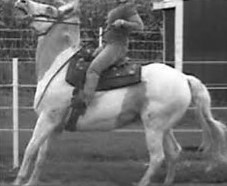

As mentioned in the previous post, personalities play a big part in the riding experience. And also in the quality of the interaction with horses. There may be many reasons why a rider pulls harshly on a horse’s mouth. Which provokes the reaction of the horse raising its head upwards and then down and in towards its chest. This example is shown in the top three photos.
The rider may be worried that the horse is bucking or trying to run off. It may be an attempt to dominate a horse, or to show off. It may be momentary or it may be long lasting. Or it may be an issue of volatility (which could be either the horse or the rider). However, it is very revealing because it is a situation of a mismatch of needs. Which can easily become the prelude to a more frequent use of rollkur.
It should also be mentioned that violent head actions both up and down can also be the result of bit problems. Dr. R. Cook describes this as: “bit-induced trigeminal neuralgia”. (from “Bit-induced pain: a cause of fear, flight, fight and facial neuralgia in the horse”; W R Cook 2003 Pferdeheilkunde)
But the intent shown by the rider above is entirely different compared to those riders and trainers who use it as a permanent feature of their training. Such riders and trainers use it as a systematic training tool to obtain certain defined objectives. Especially for collection and “togetherness”. In this case, its use is not accidential. It is deliberate. And it is used by a broad spectrum of riders and trainers, ranging from some who are very successful to many who are not. This is a significant part of the problem, since many riders and trainers mismatch skill and violence and others are looking for quick financial benefits.
Including the use and misuse of artifical aids. There is one technique in particular which has and is continuing to cause a great deal of controversy. It is the subject of this post.
The forcing of the horse’s head, neck, haunches and other parts of its body into unnatural positions will sooner or later cause problems. While there may be some positive effects which are needed to win competitions, the use of this technique will also produce a number of undesireable and (probably) unintended effects as well.
Frequently, these are swept to one side because they do not fit the narrative desired by the rider/trainer (and often owner). It is essential that their multiple effects be reviewed in detail. They will be analyzed in the next series of posts. It is important that this analysis reflect the full range of consequences.
However, it is also imperative to include the effects of these techniques on several other issues. These include muscle tone and flexibillity, the effect on the horse’s dynamics, and its ability to maintain and to improve its quality of movements. As well as its overall physical and mental health.
It is by no means certain that these aspects are enhanced by the use of artifical aids. Or that this is the only way to obtain them. Consequently, it is essential to analyze them in more detail. This is a complicated area and many aspects have not been thoroughly scientifially investigated. However, extensive quotes from leading researchers will fill in as many gaps as possible.
Consequently, there will be a mergind of research that will be supplemented by extensive experience of knowledgeable equestrians.
Let’s start by looking at this problem in its most obvious and frequent uses, dresssage, reining and jumping.


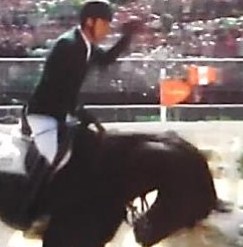
It is a problem which affects a number of other forms of riding.
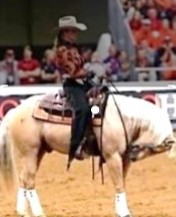
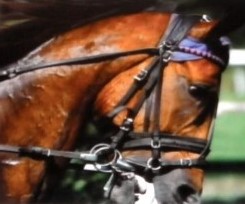

Note on middle photo of the trotter-As the accompanying photos show this is not the usual head and neck position for rollkur. However, the trotter’s head and neck position is dominated by the check rein which prevents it from descending. The consequence of this is well documented in studies performed on trotters which indicated that in this position the horse experiences a significant compression on the windpipe. The following article confirms.
“Induced poll flexion significantly affected peak inspiratory pressure (PIP) in all horses; however, PIPs were significantly more negative in those affected with DLC/Dynamic laryngeal collapse. Based upon the tracheal pressure measurements recorded in this study, DLC in NCT/Norwegian Coldblooded Trotters is a severe obstructive upper respiratory tract disorder that is induced by poll flexion.”



There are numerous ways that a mismatch is created. Heavy, hard hands is one. Artifical aids are another, including severe bits, especially those with curb chains and ports. And in particular there are draw reins.
Timid riders often use them for security, to stabilize a fresh horse, to prevent head tossing, etc. But they are also a very convenient way to get the horse’s head down and in towards its chest. And this is where the rollkur advocates make their position clear.
An important distinction needs to be made between draw reins and side reins. Draw reins have a variable length since they are attached from the girth and run through the bit and to the rider’s hands. Thus, any pull by the rider on the reins will have the simultaneous effect of pulling the horse’s head both down and back towards its chest. The harder the pull, the more the head is pulled back and in.
They operate on another principle which is that of a fixed length. This distance extends from the bit to the girth between the horse’s front legs. Alternatively they can be attached from the bit to the billets (girth straps) on each side of the saddle.
Since they are based on the principle of a fixed length, they force the horse into a fixed head position. This is done at a length determined by the rider/trainer. This length can reflect any of the HNP angles shown above.
The difference vs draw reins is that the length is fixed. It is obvious that the horse would be foolish to lean on the bit with maximum force during the entire time that the side reins are in place.
The horse quickly works out the actual length of the side rein and pulls its mouth and jaw slightly back from the position of maximum tension. This may be a distance of only several millimeters.
This reaction by the horse is what invalidates the majority of studies analyzing rein tension. And it particularly invalidates comparisons of rein pressure differences between side and draw reins and between ridden and unridden.
An exception to this condition is if the horse left for an excessive amount of time with tight side reins. When exhausted the horse will have no option but to lean on the bit.

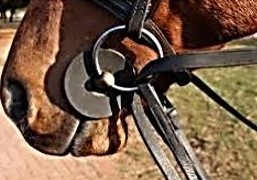

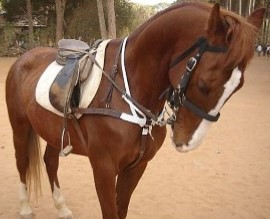
The above photo reveals the head position in rollkur created by short side reins. The angle shown in this photo is a damaging -40° degrees behind the vertical.
In fact there is a difference in the side rein structure. Which is that the ordinary riding reins have been looped around the cantle/back of the saddle. For all intents and purposes this placement produces the same effect.
This statement has been made on the basis that it is a form of training with undesireable side effects. However, it should not be dismissed that there is a genuine motive behind it. Users are seeking performance improvements in dressage and jumping. But there are good and bad ways to achieve these improvements. In later posts, Equinamity will reveal a revolutionary new way to achieve these results with much less disharmony.
It also needs to be explained that rollkur has a long history, which is essential to understand. This is the subject of the next post.